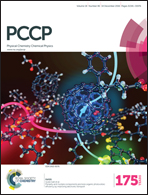Carbon-nanorings ([10]CPP and [6]CPPA) as fullerene (C60 and C70) receptors: a comprehensive dispersion-corrected DFT study†
Abstract
A comprehensive computational analysis of all possible complexes between the carbon-nanorings, CNRs, [10]CPP and [6]CPPA with the fullerenes C60 and C70, was carried out. The B97-D2 functional together with the def2-TZVP basis set was used through the work, although comparisons with other different functionals (BLYP-D2, B3LYP-D3(BJ), TPSS-D3(BJ), PBE0-D3(BJ) and M06-2X) were also performed. In order to find all the possible rearrangements of the fullerenes inside the CNRs, two methods of different complexities and computational costs were employed. After localization of all minima of interest, the corresponding complexation energies were evaluated, and subsequently, the different minima were compared both from a structural and an energetic point of view. According to our results, the largest complexation energy clearly corresponds to the C70@[10]CPP complex: −53.32 kcal mol−1. This complex shows a structure where each of the ten rings of [10]CPP directly faces a six-membered ring of C70. That is to say, the best possible overlap between the hexagonal rings of C70 and [10]CPP takes place, showing an arrangement that clearly favours the dispersive π⋯π interaction. To achieve this spatial disposition, C70 is placed fully vertically (its major diameter perpendicular to the plane of the CNR), and undergoes a small displacement of 0.769 Å from the centre of the CNR. With C60, exactly the same interaction pattern is reproduced, and it is indeed the reason for this fullerene to be just inside the CNR, since for C60 the belt formed by the six-membered rings is placed exactly at the centre of the buckyball. Basically due to the smaller dispersion arising for this C60@[10]CPP complex, the complexation energy is somewhat smaller: −49.78 kcal mol−1. All the calculations show that the ability of [6]CPPA as a fullerene receptor is rather smaller than that of [10]CPP (about ten kcal mol−1, regarding complexation energy), both for C60 and C70. This is basically due to the loss of the interaction of four phenyl rings with the fullerenes, not adequately counterbalanced by the weaker interaction with the alkyne bonds.
![Graphical abstract: Carbon-nanorings ([10]CPP and [6]CPPA) as fullerene (C60 and C70) receptors: a comprehensive dispersion-corrected DFT study](/en/Image/Get?imageInfo.ImageType=GA&imageInfo.ImageIdentifier.ManuscriptID=C6CP06209A&imageInfo.ImageIdentifier.Year=2016)


 Please wait while we load your content...
Please wait while we load your content...